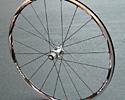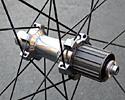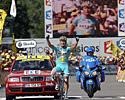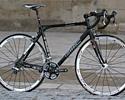
Recently on Cyclingnews.com |
Tech News – August 20, 2007Edited by James Huang Got tech? Send press releases, news, and tech questions to the Cyclingnews tech desk. |

|
A recent sneak preview of Shimano's 2008 Dura-Ace wheelsets offered up some interesting developments. In addition to the new carbon-rimmed tubular Dura-Ace models we've spotted throughout the season, Shimano will replace the current Dura-Ace WH-7801-SL model with a new WH-7850-SL set and will also introduce another clincher variant with a rather striking carbon-reinforced aluminum rim.
Not surprisingly, the WH-7850-SL wheelset will retain its compatibility with Hutchinson's Road Tubeless system and receives the same updated hub design as the rest of the Dura-Ace family. Gone are the hub-located nipples in favor of a more conventional straight-pull spoke, leaving only nipples at the rim for easier truing. Visually speaking, WH-7850-SL abandons last year's somewhat staid appearance for the more eye-popping red-and-black look of the current XTR wheelset.
Perhaps most interesting, however, is WH-7850-SL's titanium freehub body which replaces the deeply splined aluminum version that Shimano has used since the introduction of Dura-Ace 10-speed. The new body is now also backwards-compatible with 9-speed cassettes from both Shimano and SRAM, as well as SRAM's 10-speed models (woo-hoo!). The faster-engaging internals are still there, though, suggesting that this is not simply a reintroduction of the old body.

|
From our initial look, it appears that Shimano carries over the use of oversized aluminum axles front and rear. It is unclear, however, whether or not it has also kept the new bearing configuration it introduced with the faster-engaging freehub design or reverted back to the more outboard layout of its older hubs (most of you likely won't have any good reason to know what we just talked about, but shop mechanics should take note).
We don't have a model designation for the new Dura-Ace carbon-and-aluminum clincher model just yet, but rim markings suggest that it will weigh somewhere in the neighborhood of 1380g for the pair, easily putting it in competition with some high-end tubulars. The new rim unfortunately won't be tubeless-compatible, but the carbon-reinforced shallow-section rim is said to offer the buttery-smooth ride quality of carbon but with the practical (and performance) benefits of an aluminum braking surface.
As with WH-7850-SL, this new set sports red anodized nipples only at the rim for easier truing, and Shimano reinforces each spoke hole with a few extra layers of carbon. We don't know if this new set also uses the same 9/10-speed compatible titanium freehub body as WH-7850-SL, but it certainly would make sense if that were the case.
![]()
BMC comments on its sponsorship future

|
Alexandre Vinokourov's (Astana) non-negative result for homologous blood doping during the Tour de France was a major blow for all involved, particularly for team sponsor BMC, who has now fallen victim to major doping scandals from both of its ProTour ventures. In addition to Vinokourov, teammates Matthias Kessler and Andrei Kashechkin also tested non-negative for abnormal testosterone levels and homologous blood doping, respectively, all within a tumultuously short time period.
BMC promptly responded by terminating its sponsorship agreement with the team earlier this month and expressed obvious disappointment with the situation. According to Markus Zehnder, BMC's head of marketing and communication, "Everyone from the mechanics on our production line to the upper management gets behind our teams and sponsored riders. To share these victories with the team(s) is also a morale and team building tool we use at BMC. Naturally, when those victories are 'tainted' with different riders' flagrant abuse of the rules, we all feel personally affected by these actions and their subsequent results. Building up a relationship with a sponsored team takes lots of efforts and time on all operational levels. Furthermore the team is an important integrated pillar of our entire marketing, communication and sales strategy. The partnership on all these levels have been well defined and came to an abrupt stop now. "
In spite of the setback, though, BMC is continuing to look forward with a positive outlook on the future and on its existing relationship with its other sponsored teams and riders. "BMC is maintaining all other sponsorships in road cycling, mountain biking and triathlon," said Zehnder. "The relationships that have been built up over the years are based on trust, and the numerous teams and individual athletes who strive to achieve their potential with fair means day after day are extremely important to us. The constant dialogue with the athletes gives us valuable feedback for the development of innovative product concepts and helps us to continually optimise our existing models. It is therefore our intention to continue to provide the BMC athletes the very best equipment available to achieve their success."

|
Somewhat surprisingly, BMC does not anticipate its now-soured relationship with Astana to significantly affect its sales. "The image impact based on our experiences and the reactions from individuals all over the world seems to be rather small. Our products are not directly linked to doping. They seem to speak for themselves when it comes to quality, design and technical features," said Zehnder.
As such, BMC is keeping an open mind when it comes to returning to the ProTour, but not without certain contingencies. "As a sponsor of cycling, and in particular a Pro Tour team, it is important that the team's policy towards doping is openly addressed," Zehnder stressed. "The team has to define and implement transparent anti-doping procedures. As a sponsor it is also important to understand the absolute need to refrain from pressure concerning results; the rider needs to feel that he doesn't need to win at all costs. This negative pressure is also a reason riders turn to doping. In general it is a difficult topic because it is based on negative assumptions which naturally are not the preferred aspects to discuss and define in the beginning of a partnership."
BMC did have such a clause in its contract with Astana and clearly chose to exercise its right to terminate their agreement. While Astana's future continues to grow dimmer, BMC is upbeat. According to Zehnder, "A decision has been taken and we as well as Astana do plan our future accordingly."
![]()
Mavic comments on Millar wheel failure

|
David Millar (Saunier Duval-Prodir) had a disastrous ride during Stage 19 of this year's Tour de France. Almost immediately after catapulting himself down the start ramp, Millar's disc wheel failed catastrophically, but thankfully, the Saunier Duval-Prodir team mechanic was at the ready with a spare bike. Unfortunately, though, that machine suffered the same fate just a few meters up the road, laying waste to Millar's aspiration for a TdF stage win on a course that suited him nearly perfectly.
Millar was using a prototype Carbon Comete rear disc wheel from team sponsor Mavic. As compared to the existing Comete, this new model was said to be substantially lighter, at least partially due to the use of a lighter aluminum rim extrusion. Upon further examination of the race footage, it became obvious that Millar's wheel failure came about as a result of a complete separation of that bonded rim section from the disc on both occasions.
Sean Sullivan, Marketing Director for Mavic Inc., confirmed the failure mode. "David was using a prototype Carbon Comete [that was] much different and lighter than a regular stock version. I'm told the extrusion totally separated from the carbon flanges of the disc wall. At this time it hasn't been determined exactly why it happened, but it was some sort of failure of the bond between the surface of the aluminum extrusion and the inside of the carbon flange."
"While a lightweight prototype, I don't think the occurrence was necessarily from any new technologies that were used," continued Sullivan. "It just appears to be more of a freak isolated incident with the preparation of the surfaces or the bonding process on his particular wheel and not a common failure with our competition prototypes or our production Cometes. Mavic prides itself on the quality and durability of our products and while we like to push the limits of technology for our racers' benefit, we would never put any racer on a wheel that we thought might have a catastrophic failure of this nature and it's horrible that it happened."
Mavic apparently places at least some blame on the initial shock from the starting ramp, but that does little to explain the second failure. According to Sullivan, "This incident happened right out of the start gate after the slight impact from hitting the pavement off the start ramp, which then uncovered the flaw in the bond in this particular wheel. David rode the same wheel with no problems in the Prologue. It's terribly unfortunate for David to have this happen during such a critical stage of the Tour on a day where he was sure to do very well."
![]()
Photography
For a thumbnail gallery of these images, click here
Images by James Huang/Cyclingnews.com
- Shimano replaces the current Dura-Ace WH-7801-SL wheelset with the new WH-7850-SL.
- The newly updated hub features sharp styling and a new titanium freehub body.
- The same brazed-on rim reinforcements remain but wheel truing is now done exclusively at the rim via the snazzy new red anodized aluminum nipples.
- Dura-Ace adopts the red-and-black color scheme of XTR for next season.
- Shimano will also offer another Dura-Ace clincher wheelset with a carbon-reinforced aluminum rim.
Images by Cyclingnews.com
- It still remains to be seen what will ultimately become of Alexander Vinokourov and his Astana team, but one thing is for certain: they won't be riding BMC bicycles.
- The sponsorship agreement is over , but BMC is confident that the performance of the SLC01 Pro Machine and its other offerings will stand on their own just fine.
- Stage 19 was not meant to be for David Millar , who fell victim to not one, but two disintegrating prototype rear disc wheels.

